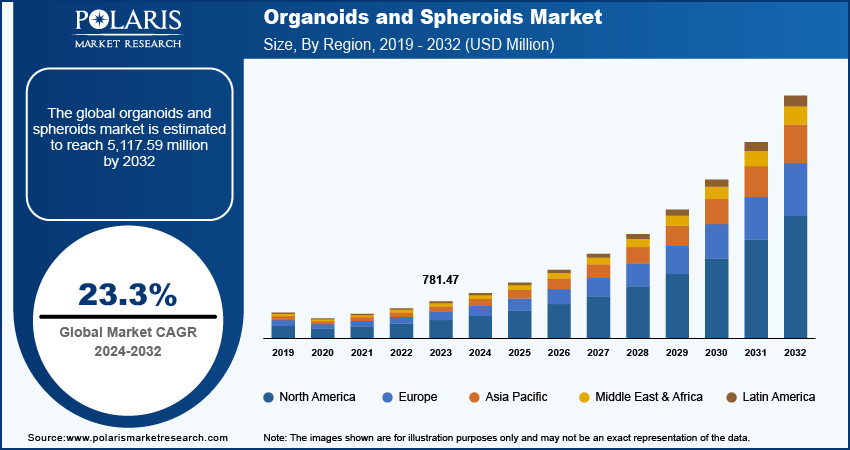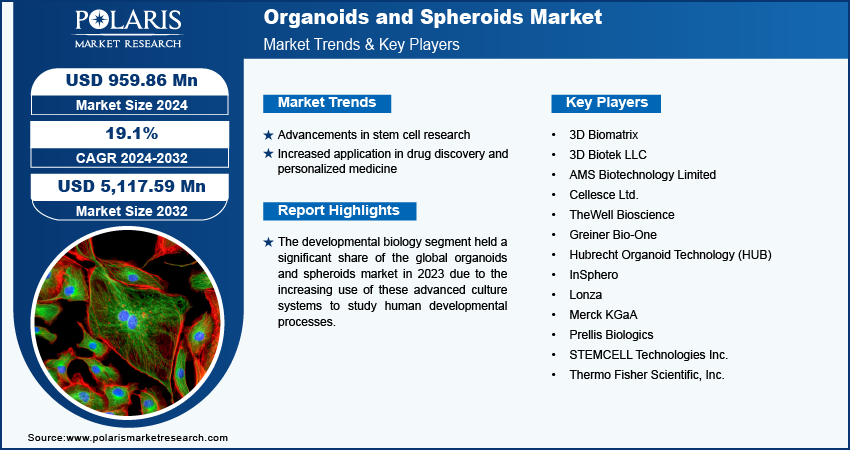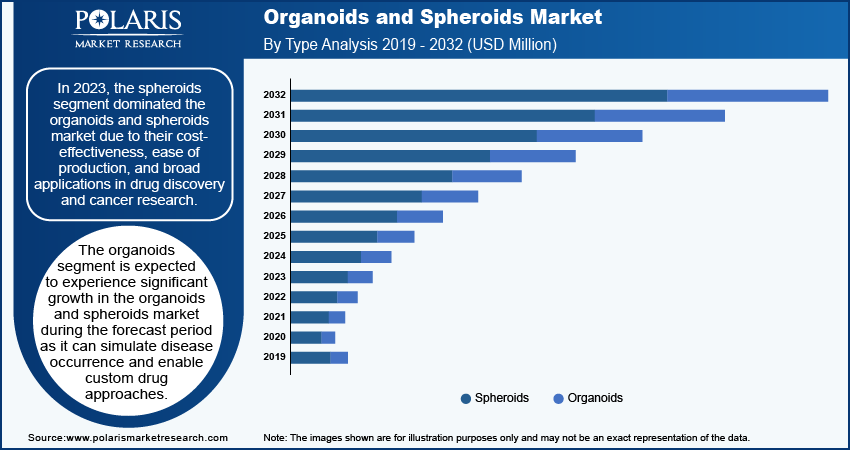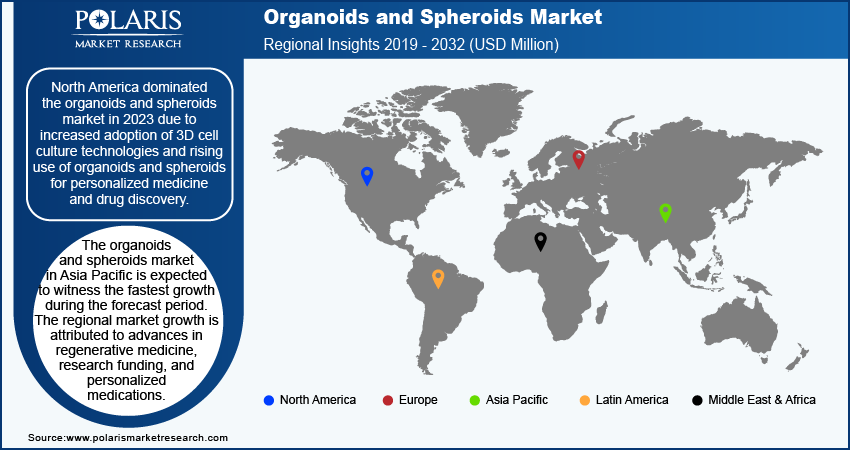
Organoids and Spheroids Market Share, Size, Trends, Industry Analysis Report – By Type (Organoids and Spheroids), Application, End Use, and Region; Segment Forecasts, 2024–2032
- Published Date:Oct-2024
- Pages: 116
- Format: PDF
- Report ID: PM1782
- Base Year: 2023
- Historical Data: 2019-2022
Organoids and Spheroids Market Outlook
The organoids and spheroids market size was valued at USD 781.47 million in 2023.
The market is anticipated to grow from USD 959.86 million in 2024 to USD 5,117.59 million by 2032, exhibiting a CAGR of 23.3% during the forecast period.
Organoids and Spheroids Market Overview
The organoids and spheroids market is experiencing significant growth due to the increasing demand for advanced 3D cell culture technologies in research and drug development. Organoids and spheroids are three-dimensional cell structures that mimic the architecture and functionality of real tissues and organs, making them valuable tools for studying complex biological processes. 3D technologies are widely used in disease modeling, regenerative medicine, personalized medicine, and drug discovery since they provide more accurate and reliable data compared to traditional 2D cell cultures. The market is driven by advancements in stem cell research, a growing focus on precision medicine, and the increasing adoption of organoid-based models by pharmaceutical companies for drug screening and toxicity testing. Additionally, the rising prevalence of chronic diseases such as cancer has fueled the demand for sophisticated models, further propelling market growth. Also, many players in the market are launching products that is driving the market revenue. For instance, in April 2024, ACRO Biosystems introduced a 3D organoid bioprocess development platform to accelerate the development of bio-therapeutics.

To Understand More About this Research: Request a Free Sample Report
Organoids and Spheroids Market Growth Factors
Advancements in Stem Cell Research
Rapid advancements in stem cell research, particularly with induced pluripotent stem cells (iPSCs), make it easier to generate organoids that mimic human tissues, which drives the organoids and spheroids market. iPSC-derived organoids are invaluable for disease modeling, replicating the genetic and cellular characteristics of specific patients, which enhances personalized medicine approaches. These organoids are increasingly used in regenerative medicine for tissue repair and replacement. Additionally, combining iPSC research with CRISPR gene-editing technology allows for the creation of more precise disease models, enabling researchers to understand the impact of genetic mutations. This progress in stem cell technology has led to greater adoption of organoids in academic research, clinical applications, and pharmaceutical development, expanding the market rapidly.
In May 2023, Roche opened the Institute of Human Biology (IHB) in Basel, Switzerland, to drive research in human model systems, specifically organoids that are human stem cell-derived. The IHB aims to unite human biology researchers, scientists, and bioengineers from academia and industry to investigate human biology.
Increased Application in Drug Discovery and Personalized Medicine
There is a rising application of organoids and spheroids in drug discovery and personalized medicine. These 3D cell culture models closely mimic human tissue architecture and function, providing more accurate and predictive data for drug screening and toxicity testing compared to traditional 2D cultures. Pharmaceutical companies are leveraging organoids to identify potential drug candidates, assess their efficacy, and reduce the likelihood of late-stage clinical failures. Additionally, organoids derived from patient-specific cells enable personalized treatment approaches, allowing for the testing of drug responses on an individual basis, thereby improving treatment outcomes and reducing adverse effects. This growing adoption in precision medicine is fueling the expansion of the organoids and spheroids market.
In March 2024, Sinai Health's USD 10 million investment will create an innovative tissue engineering platform for producing organoids to help in disease research and drug discovery. It features advanced equipment that complements current technology at the Lunenfeld-Tanenbaum Research Institute.
Restraining Factors
High Cost of Development and Production
The high cost of developing and producing organoids and spheroids is a significant barrier for the market. Creating and maintaining these complex 3D cell culture systems requires advanced technologies, skilled personnel, and specialized equipment, all of which contribute to high operational expenses. Generating organoids, especially from induced pluripotent stem cells (iPSCs), is labor-intensive and time-consuming, further increasing costs. These financial barriers limit accessibility, especially for smaller research institutions and companies with limited budgets, which hinders the widespread adoption of organoid-based models in research and drug development.

Report Segmentation
The organoids and spheroids market is primarily segmented on the basis of type, application, end use, and region.
|
By Type |
By Application |
By End Use |
By Region |
|
Organoids
|
|
|
|
By Type Insights
Spheroids Segment Accounted for Larger Market Share in 2023
In 2023, the spheroids segment dominated the organoids and spheroids market due to their cost-effectiveness, ease of production, and broad applications in drug discovery and cancer research. Spheroids are simpler and less expensive to create than organoids, making them a practical choice for various applications, including high-throughput drug screening and studying tumor microenvironments. Spheroids are versatile, as they can be formed from different cell types and are valuable in modeling tumors and assessing drug responses, contributing to their significant market share and widespread adoption in pharmaceutical research.
The organoids segment is expected to experience significant growth in the organoids and spheroids market during the forecast period as it can simulate disease occurrence and enable custom drug approaches. According to a published article by Nature, scientific studies suggest that organoids are 3-D structures that mimic organs and are utilized to study human organ development in the absence of human embryos. The ability to replicate organ-level complexity in vitro allows for accurate modeling of diseases and drug responses, provides new tools for developing targeted therapies, and reduces reliance on animal models.
By Application Insights
Developmental Biology Segment Accounted for Largest Market Share in 2023
The developmental biology segment held a significant share of the global organoids and spheroids market in 2023 due to the increasing use of these advanced culture systems to study human developmental processes. Organoids are derived from induced pluripotent stem cells (iPSCs) and embryonic stem cells and provide valuable insights into embryogenesis, tissue development, and genetic inheritance. Moreover, Organoids are widely used to model and study the development of various organs, such as the brain, stomach, and pancreas, by mimicking important signaling pathways, including BMP, FGF, and WNT. The ability to replicate and analyze developmental mechanisms with high accuracy contributes to the substantial revenue share of the developmental biology segment. The depth of understanding gained through these models drives their widespread use and investment in developmental biology research, establishing it as a dominant application in the market.
The regenerative medicine segment is experiencing substantial growth in the organoids and spheroids market due to their superior ability to replicate human organ functionality compared to animal models. These three-dimensional cell culture models show promise for pharmaceutical research, disease modeling, personalized medicine, and regenerative therapies. Hubrecht Organoid Technology (HUB), a leader in this field, has developed various organoid models that replicate human tissues such as the intestine and liver. These 3D models are utilized in drug discovery and regenerative medicine to understand disease mechanisms better and to test potential therapies more effectively than traditional animal models.
By End Use
In 2023, the biotechnology and pharmaceutical companies segment dominated the organoids and spheroids market due to the increasing interest of pharmaceutical start-ups in leveraging organoids and spheroids for potential clinical applications. Additionally, the widespread use of these 3D cell cultures in preclinical drug discovery and development processes, especially for testing drug efficacy and toxicity, significantly contributes to the growth of this segment. Their ability to mimic human tissue environments allows pharmaceutical entities to enhance drug screening and reduce the time required for clinical trials. Thus, the biotechnology and pharmaceutical companies segment remains a dominant force in the organoids and spheroids market.

Organoids and Spheroids Market Regional Insights
North America Dominated Global Organoids and Spheroids Market in 2023
By region, the study provides market insights into North America, Europe, Asia Pacific, Latin America, and the Middle East & Africa. In 2023, North America dominated the organoids and spheroids market due to the increasing adoption of 3D cell culture technologies and the rising use of organoids and spheroids for personalized medicine and drug discovery. Additionally, the presence of leading biotechnology firms and prestigious research institutions in countries accelerates technological advancements. Companies such as Organovo and academic institutions such as Harvard University and the University of Toronto are at the forefront of research in organoids and spheroids. For instance, in February 2024, Cell Microsystems partnered with OMNI Life Science to bring the innovative products CERO, CASY, & TIGR in the region to support spheroid and organoid research.
Asia Pacific is expected to be the fastest-growing region in the organoids and spheroids market. The regional market growth is attributed to advances in regenerative medicine, research funding, and personalized medications. In October 2022, AIM Biotech launched the organiX System, a lab tool to closely model human disease by adding vascularization and immune competence to organoids, spheroids, and tumor biopsies.

Key Market Players and Competitive Insights
Strategic Initiatives by Market Players to Drive Competition
The competitive landscape of the organoids and spheroids market is characterized by a diverse range of global and regional players competing to capture market share through innovation, strategic partnerships, and geographic expansion. Key companies such as Thermo Fisher Scientific, Corning Incorporated, and Merck KGaA are actively pursuing market leadership by focusing on innovation and forming strategic alliances. These organizations prioritize product development, enhancing safety, functionality, and cost-efficiency to meet the industry's evolving needs. Common competitive strategies include mergers and acquisitions. Other notable players in this market include 3D Biomatrix, 3D Biotek LLC, AMS Biotechnology (Europe) Limited, Cellesce Ltd., Greiner Bio-One, Hubrecht Organoid Technology (HUB), InSphero, Lonza, Prellis Biologics, CytoSMART, and STEMCELL Technologies Inc.
TheWell Bioscience, a Biotechnology company based in North Brunswick Township, New Jersey, introduced the VitroGel Organoid Recovery Solution, a new cell harvesting solution that can recover organoids and cells faster and more efficiently. It can dissociate animal-based ECM in just 2 minutes and complete the entire cell harvesting process in 15 minutes, compared to over 60 minutes with the leading solution in the market. This solution is designed to rapidly harvest high-quality intact organoids with high yields for various applications.
Thermo Fisher Scientific, an America-based life sciences and clinical research company, launched Gibco Human Plasma-like Medium (HPLM) in March 2021. The product is the first cell culture medium available that mimics the metabolic profile of human plasma, providing researchers with a more realistic representation of cell growth within the human body. Gibco HPLM mimics the salt concentrations and over 60 polar metabolites found in human plasma, which allows researchers to study physiologically relevant environments in disease research such as cancer. When supplemented with fetal bovine serum (FBS), it supports cell growth and viability similar to conventional media without requiring adaptation for most cell lines.
Major Players Operating in Global Organoids and Spheroids Market
- 3D Biomatrix
- 3D Biotek LLC
- AMS Biotechnology Limited
- Cellesce Ltd.
- TheWell Bioscience
- Greiner Bio-One
- Hubrecht Organoid Technology (HUB)
- InSphero
- Lonza
- Merck KGaA
- Prellis Biologics
- STEMCELL Technologies Inc.
- Thermo Fisher Scientific, Inc.
Recent Developments in the Industry
- In July 2023, Molecular Devices launched a custom organoid line expansion service, leveraging proprietary bioreactor technology to produce high-quality, assay-ready organoids for drug discovery.
- In February 2024, ATCC & Tissue Dynamics collaborated under the BIRD Foundation to develop advanced cardiac organoid-based kits for improved cardiac safety testing in drug development.
Report Coverage
The organoids and spheroids market report emphasizes key regions across the globe to provide a better understanding of the product to the users. Also, the report provides market insights into recent developments and trends and analyzes the technologies that are gaining traction around the globe. Furthermore, it covers an in-depth qualitative analysis pertaining to various paradigm shifts associated with the transformation of these solutions.
The report provides a detailed analysis of the market while focusing on various key aspects such as competitive analysis, type, application, end use, and their futuristic growth opportunities.
Organoids and Spheroids Market Report Scope
|
Report Attributes |
Details |
|
Market Size Value in 2024 |
USD 959.86 million |
|
Revenue Forecast by 2032 |
USD 5,117.59 million |
|
CAGR |
23.3% from 2024 to 2032 |
|
Base Year |
2023 |
|
Historical Data |
2019–2022 |
|
Forecast Period |
2024–2032 |
|
Quantitative Units |
Revenue in USD million and CAGR from 2024 to 2032 |
|
Segments Covered |
|
|
Regional Scope |
|
|
Competitive Landscape |
|
|
Report Format |
|
|
Customization |
Report customization as per your requirements with respect to countries, regions, and segmentation. |
FAQ's
The global organoids and spheroids market size was valued at USD 781.47 million in 2023 and is projected to grow to USD 5,117.59 million by 2032.
The global market is projected to register a CAGR of 23.3% during the forecast period.
North America accounted for the largest share of the global market due to the increased adoption of 3D cell culture technologies and the rising use of organoids and spheroids for personalized medicine and drug discovery.
A few key players in the market are 3D Biomatrix; 3D Biotek LLC; AMS Biotechnology (Europe) Limited; Cellesce Ltd.; Corning Incorporated; Greiner Bio-One; Hubrecht Organoid Technology (HUB); InSphero; Lonza; Merck KGaA; Prellis Biologics; CytoSMART; STEMCELL Technologies Inc.; and Thermo Fisher Scientific, Inc.
The biotechnology and pharmaceutical companies segment accounted for the largest market due to the increasing interest of pharmaceutical start-ups in leveraging organoids and spheroids for potential clinical applications.
